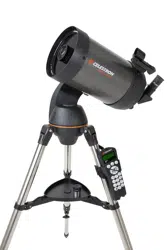Loading ...
Loading ...
Loading ...

ENGLISH I 9
The eyepiece is the optical element that magnifies the
image focused by the telescope. The eyepiece fits directly
into the star diagonal. To install the eyepiece:
1. Loosen the thumbscrew on the star diagonal so it does
not obstruct the inner diameter of the eyepiece end of the
diagonal. Remove the protective dust cap from the star
diagonal’s barrel.
2. Slide the chrome portion of the low power 25mm eyepiece
into the star diagonal.
3. Tighten the thumbscrew to hold the eyepiece in place.
To remove the eyepiece, loosen the thumbscrew on the
star diagonal and slide the eyepiece out.
THE EYEPIECE
The NexStar SLT’s focusing mechanism controls the primary mirror, which is mounted on a ring that slides back and
forth on the primary baffle tube. The focusing knob, which moves the primary mirror, is on the rear cell of the tele-
scope just below the star diagonal and eyepiece. Turn the focusing knob until the image is sharp. If the knob will not
turn, it has reached the end of its travel on the focusing mechanism. Turn the knob in the opposite direction until the
image is sharp. Once an image is in focus, turn the knob clockwise to focus on a closer object and counterclockwise
for a more distant object. A single turn of the focusing knob moves the primary mirror only slightly. Therefore, it will
take many turns (about 25) to go from close focus (approximately 20 feet) to infinity.
For astronomical viewing, out of focus star images are very diffuse, making them difficult to see. If you turn the focus
knob too quickly, you can go right through focus without seeing the image. To avoid this problem, your first astronom-
ical target should be a bright object (like the Moon or a planet) so that the image is visible even when out of focus.
Critical focusing is best accomplished when the focusing knob is turned in such a manner that the mirror moves
against the pull of gravity. In doing so, any mirror shift is minimized. For astronomical observing, both visually and
photographically, this is done by turning the focus knob counterclockwise.
Tip: If you are fine-tuning your focus, it’s better to turn the focus knob counterclockwise rather than clockwise. This
will prevent unwanted shift in the primary mirror and ensure that your image remains as sharp as possible.
FOCUSING
Eyepiece
Star
Diagonal
Focuser Knob
Finderscope
Eyepieces are commonly referred to by their focal length and barrel diameter. The focal length of each eyepiece is
printed on the eyepiece barrel. The longer the focal length (i.e., the larger the number), the lower the eyepiece
power or magnification. The shorter the focal length (i.e., the smaller the number), the higher the magnification.
Generally, you will use low-to-moderate power when viewing. For more information on how to determine power, see the
section on “Calculating Magnification,” (page 14).
Barrel diameter is the diameter of the barrel that slides into the star diagonal or focuser. The NexStar uses
eyepieces with a standard 1.25” barrel diameter.
Loading ...
Loading ...
Loading ...
